Hello Reader,
Just a friendly preface to this short ten-point blog post. I am a scientist, or I’m a scientist in training I should say. I’m currently completing my PhD at Monash University in Parkville. In other words I already have an undergraduate qualification in science (4 years of work), and I did quite well at it… So I know my stuff. I’ve tried to communicate some of this stuff here for you in simple language… partly to have a whinge, and partly because I’m worried for you, on your behalf. Genuinely.
I am worried because there are a lot of (flagrant) lies being presented as truth on the internet, and without the proper academic background, you’re simply left to trust the ‘experts’ despite all the anti-vaxx, chemical-free, organic penis-heads* preaching contrary views to the medical profession. For the mothers out there, trusting an emotionless doctor over the emotionally skewed arguments everywhere on the internet can be worrying…
So, I’ve decided to actually stop secretly complaining about this stuff and write something about it. I’ve compiled a list of ten points from the pseudoscience (meaning: fake science) gallery to help out with this stuff…
Please note I don’t mean to sound condescending or to come across as if I’m attacking YOU instead of your views. YOU are a good person. A cherished gift to humankind. And an intelligent soul capable of reason and greatness. However that doesn’t mean that YOUR OPINIONS can’t be wrong. There is a difference between yourself and what you think, and I should probably make clear that it is the latter I am attacking, not the former. You’re cool. I like YOU. And I hope you appreciate my attempt to start to help you out with a few things… there are some views out there that can actually be quite dangerous, even if they’re only just a little embarrassing to espouse most of the time.
First off… chemical names in science… We should probably start by saying that everything is a bunch of chemicals. The air we breathe consists of chemicals, the computer (or phone) you’re reading this from is chemicals… More importantly, chemistry uses a language to name all of these chemicals, which makes a lot of sense if you get the language, but the lack of knowledge can make it a little intimidating if you don’t… My first point…
-
Just because a chemical sounds scary doesn’t actually make it dangerous.
A while ago (I think it was in the 90s) this prank was circulating around the States of America like wild-fire. People were actually falling for it! Senators across the country were moving to have this banned based on advice from ‘natural health’ groups… And yet…
People who got up to year 8 science (or probably even year 5) would know that the chemical formula for water is H2O. This means, two hydrogens and one water. People who didn’t go into higher science probably wouldn’t have learned that just as the symbol ‘7’ can be written as ‘seven’, the symbol for water, ‘ H2O’ can be written as ‘Dihydrogen Monoxide’… Meaning, two (di) hydrogens, and one (mono) oxygen are in this compound. So, Dihydrogen monoxide (DMHO) is just water. And the brilliant thing about the prank above, and other pieces of misinformation like it, is that everything the prank says about DMHO is literally true, but is presented in such a way as to scare us and gear us toward some hidden agenda.
Case in point, if some prankster alternative quack is trying to sell you ‘mercury free’ water for $100 a litre… don’t let your judgement be based on the initial fear of hearing a chemical name you don’t understand. Do the smart thing. Google the sh*t out of that chemical. Understand that concentrations affect toxicity and that it doesn’t matter if a negligible amount of Hg is in water. See that I just used a symbol (Hg)… If you don’t understand it, Google is your friend… Do some independent research… Then decide whether what people say makes sense to you.
I once got my high school chemistry teacher to sign a form aiming to ban DHMO from the school… when she realised her mistake she rushed off to her office to white out her signature on the petition!
One common thing people will do on the internet, especially when they want to believe something but don’t understand the background of it, is present half the scientific story in such a way that it backs up their world view, but is not representative of reality… Don’t fall for it! You’re smarter than that and I have the best faith in humanity… If you see a post online imploring you not to eat table salt, because it’s super-toxic-bad-for-you, then treat it just like these flyers you’ve seen here about water. Don’t believe it til you’ve Googled it to hell and back and actually understand the background behind what they’re saying.
-
“Low carbs” only means anything when there actually are “low carbs”.
Okay so this is actually a little scary…
TL;DR – if you look at this picture, they’re redefining what a carbohydrate is just because they want to use their made up definition to say their product is ‘low carb’… If you used the actual definition of a carbohydrate, there are actually about 18g of sugar in here.
This is frustrating for me because it destroys consumer trust in a product and adds fire to the allegations of many that corporations are putting chemicals into our foods and lying about it.
Also, imagine if some diabetic saw this and thought ‘Only 2g of carbs! I should be sweet…’
And then had to go to hospital that night because they thought they could eat ten of these and be safe…
Or imagine a parent of a diabetic child! Imagine if that happened to her! How would she feel then…?
So yes… there is a lot of pseudo-science in marketing… people will blatantly put stuff on their products that sounds scientific to mislead the consumer into buying their product… And if you’re someone who feels like this is WRONG and needs to change… then you need to stop buying products that use fake-science.
And if acknowledging something as ‘fake-science’ or ‘pseudo-science’ clashes with your belief system, then your beliefs need to change so that you stop getting manipulated with lies coming from businesses who don’t care how they sell their product, as long as they do…
Just trying to help… Which is why I’ve brought up my next point…!
-
“Natural” is not always better, “Organic” anything is just false advertising and “Chemical Free” doesn’t actually mean anything.

|
There is a trend in marketing to attribute the word ‘natural’ to products… and the word natural is meant to imply a minimal amount of processing by man… There is also this fallacy flying around that ‘natural’ things are better for you… Which is actually rarely true if you think about it. You know what else comes from nature? Bears. And poison ivy. And cyanide. And chemicals. Because everything is a chemical right? Oh and fish that swim up your dick. They’re in nature too. And fucking piranhas. They’ll eat you ALIVE. Case in point, nature isn’t this warm fuzzy thing that wants to hug and nurture you always… People attribute a lot of positive emotion to nature, which is all well and good when hiking and enjoying a view, but not exactly relevant with everything to do with nature… nature can be terrifying… There is a reason we all tend to avoid living in mud-huts and caves… And you know what else is scary? The fact that people buy into the whole marketing lie that ‘natural is good’. All the nasty chemicals that can kill you, every single one of them, came from NATURE, before people started finding ways to make these same chemicals themselves… Always remember that… Natural is not always better, only sometimes… Think about it. Is snake venom good for you just because it’s natural? On another note, whenever the word chemical is used on food packaging, it isn’t meant to mean ‘nasty substance that will hurt you’. That’s another example of marketing inventing their own definitions for words… |
The word ‘chemical’ is singular for the word ‘matter’ which means ‘anything that has mass and occupies space’. How many things can you think of that have mass and occupy space? LITERALLY-FUCKING-EVERYTHING. Except some really esoteric sub-atomic particles… So the next time you see the word ‘Chemical Free’ on a product… Don’t buy it… Please just remember reading the comic strip alongside and have a chuckle… Because what they’re saying makes no sense…
Also, the word ‘organic’ refers to chemicals that comprise carbon. So basically anything that uses the marketing label ‘organic’ isn’t actually saying ‘this is made without nasty chemicals that will hurt you’. The word actually means that the food comes from another living organism of some kind… And no, you can’t have ‘organic sodium chloride’ or ‘organic pre-workout’…
Basically this whole marketing gimmick relies on the idea that the consumer is stupid and will buy any product, as long as corporations tell you that all chemicals are bad, when you know that all chemicals are not bad for you…
Food in Australia is tightly regulated by the FDA… If there were chemicals in any of the foods on the market that could hurt you… those foods would simply not be on the market… Don’t let corporations lie and manipulate you out of your money… Stand up!
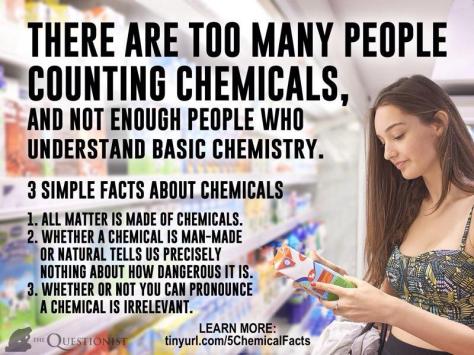
-
GMOs are not bad for you… stop advocating for the labeling of normal fruit and vegetables.

Stay with me for a second… While information generated through one person alone can be fallible, information generated through the scientific method is generally always close to true. And if not, then the method self-corrects when shown to be wrong…
Wouldn’t it be a beautiful world if someone who believed something, when shown the evidence that contradicted their beliefs, went, “You know what? I’m probably wrong. I’ll change what I think is true now.”
Well you know what… science does just that! And here’s the method. Anyone can follow it.
Following this method is literally what led to the creation of modern medicine, the internet, cars, machines used for industrial processes, aeroplanes (as if a big hunk of metal could fly without science!), and many more things that have saved lives. Because the scientific method works! And the best thing is, if an idea is wrong, then an experimental result will eventually prove that idea to be wrong… And the sensible thing to do is to follow the evidence…
Simple experiments we can do for ourselves include those which test gravity. If you throw a glass at the ground, then 100% of the time, the glass will smash, and from this you can realise that, okay, maybe you shouldn’t jump off a bridge, because wishful thinking and faith won’t make you fly.
In the same way, just thinking that GMOs are unsafe is not enough. To think this and be considered not-crazy at the same time, the evidence has to pan out. And it doesn’t. GMOs have unanimously been shown to not be harmful in literally every scientific investigation in the last ten years. Read for yourself below:
http://www.tandfonline.com/doi/abs/10.3109/07388551.2013.823595
And as someone with a university qualification in science, I can tell you right away that it makes no sense at all that GMOs would be toxic. Modified DNA in GMOs is treated by the body in exactly the same as ‘normal’ DNA in wild-type products. In other words, both modified and wild-type DNA are broken down into (the same) non-functional, digestible components before going into your blood or cells. It makes no sense that GMOs would hurt you…
I think it comes down to the idea that people think GMOs are unnatural… but they ingore the fact that the genetic modification that is done in a lab assisted by humans is exactly the same as a more random genetic modifcation that can happen with plants anyway! Horizontal gene transfer (done by nature) is exactly the same process as genetic modification (done in a lab). It’s just that people are beginning to genetically modify crops in ways that benefit farmers and produce higher yields…
This is a fact… if you’re refusing to accept it and want to remain thinking whatever you feel like… then please refer to this article:
Thinking whatever you feel like because it’s convenient to you is the reason the Earth is suffering from human-induced climate change (separate topic, but yes there is an abundance of scientific evidence for that too…!)
Change in a positive direction…
Remaining stagnant and believing out-dated, falsified things breeds reptiles of the mind… Dinosaurs went extinct because they could not adapt… We’re more than reptiles and it’s time to prove it…

-
Gluten is just wheat protein… if you’re not gluten intolerant then you don’t have to stop eating it.
Seriously if you think a protein is bad for all people just because some people are allergic to that specific sequence of amino acids… Then you probably need to look up what causes allergies and what a protein is… then just Google search the sequence for gluten… the truth is never far away.
6. “Isotonic” sports drinks are not necessary.
“Isotonic” by definition means, having the same particle concentration as the blood… Your kidneys and lungs both monitor physiological pH, so that means that your H+ and OH- ions in your blood are both being kept in check by your kidneys and lungs! You don’t need to do anything… Likewise, your kidneys and cellular processes help you out internally by monitoring the concentration of every other mineral that you consume. You do not need to drink or eat substances that have the exact same concentration as your blood… Your own body takes control of that stuff! If there’s anything in here you didn’t understand, feel free to run a simple Google search to look for and understand the information yourself!
Don’t let corporations treat you like an idiot. Buy an alternative, cheaper brand and send them a message…
7. You cannot physically alkalise your blood—so stop pretending an ‘alkaline’ diet is evidence based.
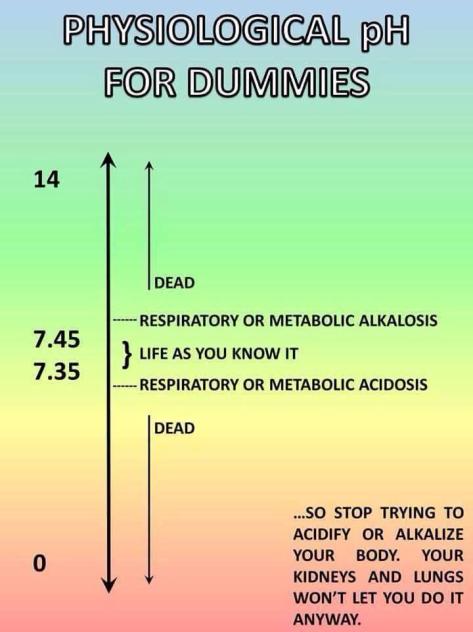
Pretty self explanatory. Your internal, automatic physiological processes monitor your blood pH for you (around 7.40). They will keep your blood at this pH. Likewise, it will keep your gut at pH 2, which is much more acidic. You cannot alkalise your blood. Your kidneys will eliminate excess acid. Your lungs will also play a role in maintaining blood pH. Cellular active transport will establish different pH values in different parts of the body, as needed. This will all happen regardless of what you eat. So don’t bother with alkaline diets – they are not based on evidence or anything that remotely resembles reality… Free yourselves from nonsense…!
-
Coke zero is bad for you, because, “chemicals”.
A lot of people would have seen this picture:

Or even this one:
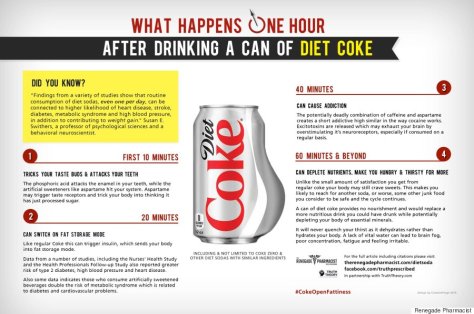
The problem with it, is that you can more or less make any picture like this for anything. Remember the Dihydrogen Monoxide prank? Someone used some scientific mumbo jumbo on people, relied on the fact that they probably weren’t going to understand it, relied on telling half-the-story to position people towards a personal agenda, and got politicians rallying to ban water in several American states… Well here’s a similar picture to those above… except this time, the substance being attacked is water…

There is a tendency when people don’t understand something, to react to this unknown presented to them with fear… But we are better than that… Next time you see something like this… I challenge you… Stop and think… Breathe calmly. Does this make sense? Yes? No? Why or why not? If it makes sense because you lack information, then Google is your friend. If you think it makes sense because it’s quoting words that sound professional and scientific to make its point, then you are likely to be mislead and taken advantage of by advertising gimmicks…
There is a tendency to fall for the whole naturalistic fallacy… The idea that what’s natural is what’s best, even though that’s not the case always. For people still believing this, I present to you… Kale smoothies!
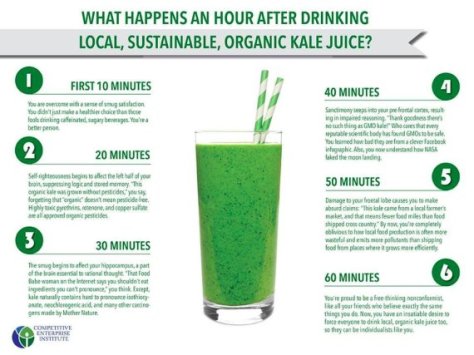
There is also a trend in marketing to say that some kind of food is tocic (like regular table salt) so you should buy this alternative product instead (like himalayan rock salt…) Feel free to Google it. But don’t believe it… They’re lying to you. There’s even people claiming to be medical doctors (on the internet) when I really doubt whether they are, because they either don’t know their sh*t or they’re lying to you.
Here I’ve provided an article arguing the toxic effects of broccoli… in order to illustrate just how easy it is to mislead people with half the story! These people prey on your lack of knowledge, tell you a half truth backed with science that’s out of context, and then then fill in the gaps with lies… Enjoy… 🙂
Broccoli is bad for you! Like, really, really toxic bad for you…
-
“Vaccines are dangerous because I don’t understand what’s in them” – Translation: you are dangerous because you want to be ignorant of science for no reason.
This person nails it better than I ever could… Please enjoy reading this… I know I did…
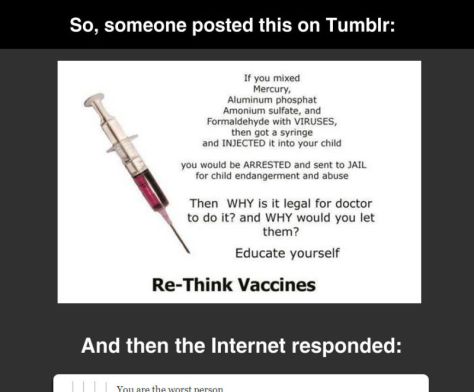
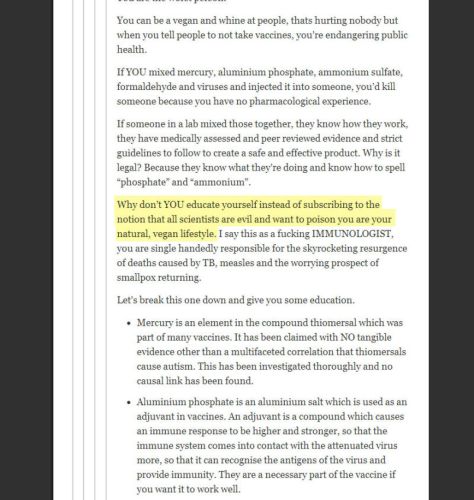
Also, here are some graphs showing the incidence of disease before and after vaccines for those diseases were introduced… Feel free to browse. Vaccines are sold to you (cheaply I might add) because the world cares for you, not because big pharmaceutical companies are out for blood.
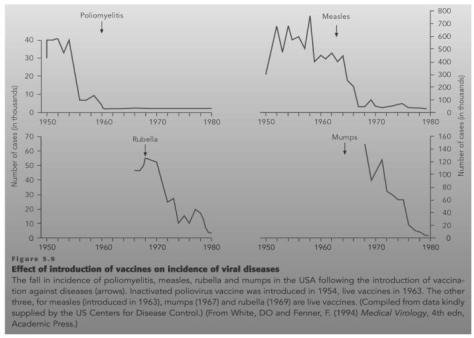
As you can see, in all cases above, when a vaccine against a disease was introduced to the market, the incidence of that disease declined, as did the mortality rate…
For more information on how vaccines cause autism, feel free to follow this link here:
-
“Every opinion is valid and I’m entitled to think whatever I want and be right! I am entitled to my opinion.”
Translated… “I don’t have anything better to say and want to make you look like an asshole for denying me my right to believe in things like the Easter Bunny or Santa.”
It’s the academic equivalent of a toddler waving their arms around screaming at someone when they don’t get their way.
The truth is you can think whatever you want. You ARE entitled to an opinion. But if you want to be right… you are not entitled to your opinion. You are only entitled to what you can prove and argue for! If you have evidence or a coherent logical argument to present, feel free! The thing about science is, if you can prove someone else’s views to be wrong, they are forced to change their mind…
For more information on why the ‘I‘m entitled to my opinion‘ argument is actually a ‘I don’t know what I’m talking about and don’t feel like justifying myself so I’ll try and make you look like a tool for no reason’ argument, feel free to read this article:
http://www.houstonpress.com/arts/no-it-s-not-your-opinion-you-re-just-wrong-updated-7611752
Also, if you feel you want to discredit any of the facts provided in this info-piece, feel free to use this as a template… it’s what most other people who’ve wanted to believe whatever they want despite being wrong have done…








 the hip. Origin: Anterior-inferior iliac spine of ilum. Insertion: Top of patella and patellar ligament.
the hip. Origin: Anterior-inferior iliac spine of ilum. Insertion: Top of patella and patellar ligament.
 the medial side, while the biceps femoris is on the lateral side. They can also assist hip extension.
the medial side, while the biceps femoris is on the lateral side. They can also assist hip extension.
 Hammy group? This guy has a lot of friends). The group also for some not fully clear to me has been called the “Goose Foot”, but I am guessing it has something to with the anatomical look when they all inserts at the same place.
Hammy group? This guy has a lot of friends). The group also for some not fully clear to me has been called the “Goose Foot”, but I am guessing it has something to with the anatomical look when they all inserts at the same place.


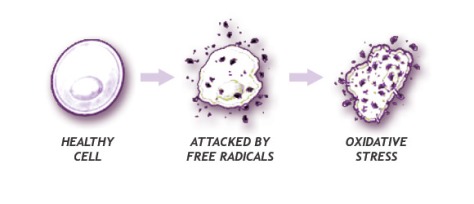







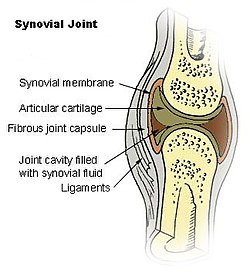






 s probably the key factor of what a kid eats, for example packing them full of lollies to make them shut the **** up. This influence of course diminishes with age but remains a key factor, as it is the parent that can choose what to stock the fridge with, as well as most of the time choose what a meal will contain.
s probably the key factor of what a kid eats, for example packing them full of lollies to make them shut the **** up. This influence of course diminishes with age but remains a key factor, as it is the parent that can choose what to stock the fridge with, as well as most of the time choose what a meal will contain.


 e key is to drink water before, during and immediately after. The guidelines (assuming that the exercise lasts about 30-70minutes) are: 150-200ml for children, 300-400ml for adolescent 45minutes before exercise. 75-100ml for children and 150-200ml for adolescent during. A liberal good amount as soon as possible after exercise for both.
e key is to drink water before, during and immediately after. The guidelines (assuming that the exercise lasts about 30-70minutes) are: 150-200ml for children, 300-400ml for adolescent 45minutes before exercise. 75-100ml for children and 150-200ml for adolescent during. A liberal good amount as soon as possible after exercise for both. Ergogenic aids (for athletes)
Ergogenic aids (for athletes)